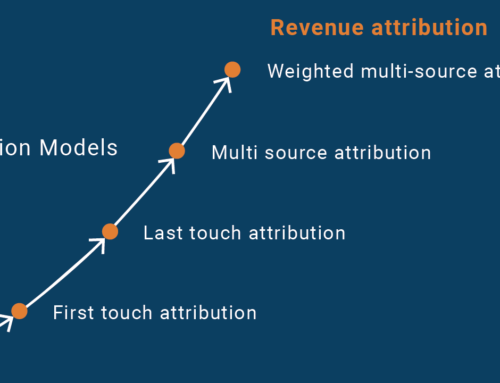In a recent piece featured by MarketingProfs, Laura Patterson explored the notion of three categories of key performance indicators (KPIs) that determine success in online marketing endeavors: outcome metrics, performance metrics, and process metrics.
This is a useful framework for developing an approach to decoding and prioritizing the KPIs that you select for your conversion optimization efforts as well – whether you’re developing tests to help improve lead generation, ecommerce sales, or subscription performance. Here’s a closer look at why KPIs matter in your conversion efforts and how selected strategies can help you uncover the KPIs that have the most impact on how you do business.
 Does your business need to focus on KPIs to help improve your conversion testing?
Does your business need to focus on KPIs to help improve your conversion testing?
Image source: Flickr User Mark Hunter
Adopting a KPI Mindset
For many firms embracing the idea of conversion optimization for the first time, it’s natural to be tempted to go into testing overload. Suddenly, you want to test and measure everything at once. A number of different factors can be driving this reaction.
The issue could be that there are several opportunities for improvement within your company or website, and it’s easy to identify those from the start. In this case, the main focus is determining the real value of each of the KPIs, and learning how to prioritize them.
Another reason that companies take this scattershot approach is a lack of understanding about how the best conversion optimization programs operate. I always advise my clients that it’s important to approach CRO in a systematic way. There are numerous reasons for this. Each test that you conduct gives you valuable information on whether a point you’re focused on is truly important to your business or not.
Systematically identifying and testing these ideas allows you to eliminate the KPIs that don’t matter and focus on the ones that do, so that you can capture the maximum value of those changes for your business. The data you gather from tests lets you confirm and disconfirm hypotheses about your business, and this kind of collective intelligence informs an ever more effective testing plan. A lack of clear objectives in testing leads to missed opportunities and a divided focus. Using KPIs in your testing structure will ultimately lead you to the right performance indicators for your business.
KPIs align with a lean testing and lean operational approach
For bootstrapping entrepreneurs and small businesses, it’s important to identify your testing “minimum effective dose.” Previous posts have explored the idea at length that we operate in a world where it’s possible to collect information on nearly every aspect of your business. The challenge is focusing your time, technological resources, and financial investments into measuring, testing, and improving what really matters.
KPIs offer a way to operationalize this theory. One of the most common questions that companies face when they start conversion testing programs or decide to scale them is where to focus. The best answer is usually possible to glean by finding the intersection of two points:
- What are your business’ most urgent goals?
- What areas of your business design or structure (or your website design and structure) are holding you back?
Take the example of a struggling ecommerce site, for example. If you are getting traffic to the site in question but people aren’t converting, then your priority becomes data collection and analysis to find the problem. Perhaps you uncover a high abandon rate in your checkout process. Then it’s clear that your focus is to reduce friction from that stage of the buying process.
Another example might be a business that’s just launched and needs customers. How can you raise your visibility and generate leads? Your primary objective is raising brand awareness and developing relationships that funnel leads to your site. So what’s holding you back? The answers could range from a lack of quality content early in your funnel to a dearth of information on how to reach your audience. Whatever you’re currently facing, by pin pointing the intersection of these two things (your business’ most urgent concerns and the area where things are breaking down), you will be able to hone in on the areas where you should start to investigate.
From there, you’re ready to move on and start to identify individual hypotheses on what’s going wrong and testing solutions to fix them. When these align with your KPIs, you’re on the right track.
Three categories of KPI and their relationship to conversion optimization
There are substantial differences between each type of KPI and how they influence conversion optimization. Let’s take a closer look at how each one operates individually and how you can put them together to learn more about identifying your business’ most urgent areas for focus and further inquiry. Below, we’ll focus specifically on the use of KPIs to drive more effective testing, and then extrapolate out to how that impacts your bigger business picture.
Outcome metric: An outcome metric is what drives a conversion program; that is, what you’re setting out to achieve. It’s also probably your business-level KPI. In many cases, it’s an increase in sales. However, it’s often actually a very specific number that will put the ROI of a conversion program into the “profitable category.” In other words, a business owner may say, “in order to justify a $10,000 investment in conversion optimization this year, I need to increase my sales by 3%.”
While it’s hard to control outcomes, a good conversion optimization program won’t be launched unless the return is reasonably assured in connection with the metrics you’re considering and tests planned. The increase in revenues, exposure, or conversions needs to be enough to justify the efforts. If what you’re considering wouldn’t move the needle in a meaningful way, it’s time to step back and look for other opportunities to focus your efforts.
Performance metrics: Performance metrics relate to what it is, specifically, that we do in the course of an activity. Think about these in the context of an employee review. Employees might have a goal such as opening ten new accounts a quarter, or releasing a new product by the end of the year. It’s about breaking down what we do in the course of an activity into measurable and digestible chunks.
Within the world of conversion testing, performance metrics relate to how big your testing agenda is, how you’re focusing, and what you need to get done in the course of a specific period.
Process metrics: Process metrics are about how tests are executed and structured. What tests will you conduct, for how long, and with what specific goal in mind? What tools will be used? Our process metrics are about what we need to do in order to realize the specific performance metrics that we’ve laid out.
For conversion optimization programs, this relates to setting specific goals that determine success or failure in a test. It’s important to note that the vast majority of tests that you conduct will show only minor improvements or may even result in negative percentage of conversions for a specific factor. Many entrepreneurs are shocked the first time their bold new headline actually leads to a drop in conversions. These failures are not failures per se, as we learn from them. But clear metrics are important to interpreting the feedback that specific tests are giving us.
Setting performance metrics for specific tests gives us a green light or red light on whether to conduct further testing, implement what we learn, or go back to the drawing board to reimagine what is possible.
Embrace the notion of incremental improvements
We’ve all read the case studies of A/B tests that increased conversion rates by 400%. These home run wins do happen, but they are the exception rather than the norm. As a result, many entrepreneurs and small business owners lack a realistic understanding of the kinds of improvements to expect.
Successful businesses are usually the result of making good decisions on a daily basis and the compounding power of small wins. Such is also often the case in conversion testing. By using specific KPIs to focus your testing agenda, and to structure your own tests, you’ll be able to track your success along a very specific line of testing. Over time, the compounded efforts of a series of testing on a certain area of your business – for example, building your subscriber list or simplifying the checkout process – leads to more sales, more profits, and more visibility.
Conclusion
When you’re setting out to develop a testing plan for your company, it’s important to really focus your efforts. KPIs are an incredibly useful mechanism to decide where to devote limited human, financial, and technological resources in testing. A KPI approach also makes it possible to track your progress over time and focus on the essential aspects of a successful business and a successful testing program. Use the outcome – performance – process framework to drill down on what you’re trying to achieve and reverse engineer the results you’re looking for. The compounded benefits of incremental improvements and small wins in your business’ most important KPIs can lead to near exponential growth over time.
What approach do you use to determining which KPIs are most important for your business? Let me know in the comments below.




